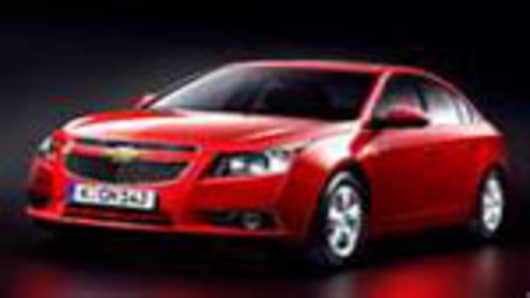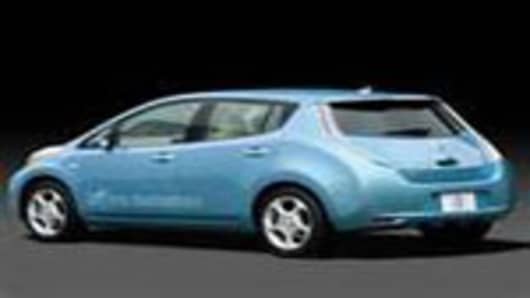The sheer number of hybrid and electric vehicles on display at the 2010 North American International Auto Show in Detroit certainly illustrates the green commitment of automakers, but other—more significant—environmental improvements will be less noticeable.
“People are ignoring the improvements in overall efficiency," says Morningstar auto analyst Dave Whitson.
Though the Obama administration's stimulus package budgeted $2.4 billion for electric vehicles and demand for hybrids continues to grow, we’re still a long way from steering U.S. drivers away from fossil fuels for good, says Whitson.
Analysts say incremental improvements in existing combustion engine technologies will play an important role, while new technologies gain traction and prove themselves to consumers.
Whitson points to many smaller improvements, such as more aerodynamic design, improved turbochargers and lighter materials that are drawing the industry closer to the administration’s goal to increase fuel efficiency to 39 mpg for cars and 30 mpg for light trucks by the 2016 model year, versus the general 25-mpg standard of today.
These efforts include Ford Motor’s Eco-Boost engines that promise 20 percent greater fuel efficiency via new turbo charge and injection technologies, and GM’s Chevrolet Cruze—planned for the 2011 model year—that Whitson says could achieve 40 mpg with a more efficient gasoline engine, at about half the price of their all-electric Chevy Volt and while approaching competitor’s hybrid models on fuel efficiency.
The Detroit auto show will showcase 20 electric vehicles in its “Electric Avenue” display, but the electric vehicle segment likely won’t be profitable for a long time.
“There are a lot of misconceptions that scale will drive the prices way down,” says Sue Cischke, group vice president for sustainability, environment and safety engineering at Ford, and the firm’s chief sustainability officer, about the battery technologies that typically make up half the cost of electric vehicles.
But even if new battery developments now in the pipeline get costs come down to $400/kwh from the current $700/kwh, Cischke says it’s still expensive.
“Automakers are going to lose money on these,” says Morningstar’s Whitson, about the current generation of lithium-ion battery technologies—available in electric vehicles like GM’s soon-to-be released Chevy Volt and Nissan’s Leaf, which he considers a big limiting factor in terms of profitability and vehicle performance.
Aside from higher upfront cost to consumers, the biggest issue is that current and proposed green drive trains—like hybrids, all-electric, fuel cells, natural gas, biofuel flex-fuel vehicles and even hydrogen—only work in either certain regions of the country or for certain purposes, essentially making them niche products.
Hybrids may work very well in stop-and-go traffic in congested cities but have slow paybacks if used mainly on highways, while electric vehicles have limited ranges and power for heavy loads.
Consumers in smaller urbanized markets with homogenous--and high--gasoline prices, such as Europe and Japan, find these alternative vehicles very attractive because the payback for the owners is quicker and they don’t use their cars the same way Americans do.
Automakers are still crying to create greater appeal, especially in a challenging economic climate.
Ford’s Cischke says a maturing and more savvy consumer base, tougher regulation and volatile gas prices have pushed her firm’s efforts away from the status-symbol marketing of early hybrids, toward ensuring the right customer gets the right car for their needs, at the right price.
Ford now plans to offer Eco-Boost, hybrid and electric drive train options for the Focus family of small cars by 2012.
“We looked very closely at this,” she says about their coming efforts to market green drive trains as just another option that customers can evaluate on price and performance across one vehicle platform. “Not everyone wanted that [green] badge on their chest. Now that challenge is how do you do this more affordably.”
Good or excellent gas mileage is enough for some. According to the Alliance of Automobile Manufacturers, AAM, an organization representing automakers with 80% of the US market, there are currently 180 vehicles offering 30-plus mpg fuel efficiency out of the 1000 vehicle options available to U.S. consumers.
That includes 32 hybrid vehicles, 15 clean diesel vehicles and 90 E85 ethanol-ready flex-fuel vehicles.
Alternative energy vehicles, however, still make up a small portion of the overall U.S. fleet. AAM counts 290,000 hybrids among the 10.6 millions cars and light trucks sold in the U.S. in 2009. Almost half—139,000--were Toyota Priuses.
Morningstar’s Whitson says the US saw “a big shift” to compacts and hybrids when gas prices touched $4-a-gallon in the summer of 2008, but we’ll need to hit that level again to see greater interest in all-electric vehicles or hybrids.
“Everyone is concerned with fuel prices,” says Ford’s Cischke. “However, there isn’t the drive into small vehicles there was two years ago.” But she adds that while a past generation of Americans shied away from smaller cars due to cheap gas prices, today’s younger drivers are looking for more value.
A lack of infrastructure is another limiting factor, whether it’s the recharging stations and electricity transmission needed for electric vehicles, or the additional storage and distribution networks needed for other alternate fuels.
Though critical, that is not the job of automakers. "Our goal is to develop automobiles,” says AAM spokesman Charles Territo, adding that automakers already spend $80 billion on research and development.
While start-up electric automakers like Tesla and new offerings like the Volt and Leaf grab headlines, Territo says greening the nation is about much more than that.
“There is no one silver bullet that will drive our goals in energy security and (controlling) greenhouse gas emissions,” he says. “It’ll take diverse technologies and it’ll take time.”






